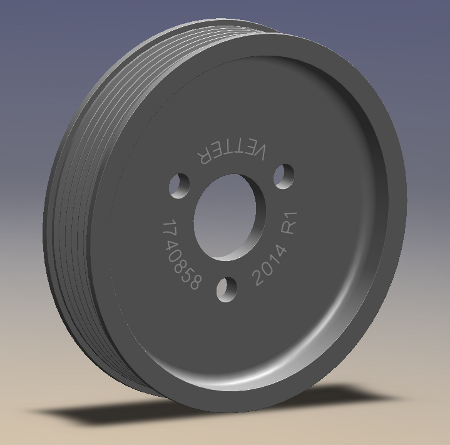Wednesday, May 5, 2014
Billet pulleys: A lesson manufacturing economics
From the time I was very young I have been a “hands-on” guy. Whenever I've wanted to build something I would do a simple sketch on paper, acquire the necessary materials, and then build the thing in my garage with my own hands. Last year I decided to do something about my stagnant salary and to get into manufacturing. I knew going in that my time was limited and I wouldn't be able to be hands-on with everything so I decided to focus on product design and engineering, and then outsource manufacturing to people better equipped to build and finish the parts en masse.
Since virtually everything today is designed in 3D CAD software that led me to evaluate several CAD packages. At the end of the trials I wound up springing for a copy of Solidworks. It was far from cheap but with 60% of the market and every build house expecting to receive Solidworks formatted data it seemed like a no-brainer. Six months in, I think I made the right choice, at least from a design point of view.
 Learning how to drive Solidworks has been a non-trivial exercise largely because,
despite its intuitive interface, its complexity mirrors its capability. But
there's a reason why the industry makes a clear distinction between those who
drive the CAD tools and the engineers that specify exactly how the product
should be built. The last six months have been more about learning the science
of materials and the art of cost-reduction than knowing where to click, if
you know what I mean. As it turns out, it's very easy to design things that
look great in CAD but cannot be built, practically or economically.
Learning how to drive Solidworks has been a non-trivial exercise largely because,
despite its intuitive interface, its complexity mirrors its capability. But
there's a reason why the industry makes a clear distinction between those who
drive the CAD tools and the engineers that specify exactly how the product
should be built. The last six months have been more about learning the science
of materials and the art of cost-reduction than knowing where to click, if
you know what I mean. As it turns out, it's very easy to design things that
look great in CAD but cannot be built, practically or economically.
Since I'm a BMW guy (who would have guessed, right?) I decided to design a set of billet aluminum pulleys for M52 applications and sent RFQs for a short run of 50 each to several local machinists. I chose 50 because I figured it was a high enough number to make it worth the machinists' time and yet low enough to keep the initial investment reasonable as I tested market acceptance. It would be an understatement to say I was astounded at the quotes I received. I'll spare you the exact numbers but will say they were several times the retail price of the factory plastic piece, to say nothing of the Chinese (URO Parts) imports.
Those of you with experience in these matters are probably slapping your foreheads and screaming at your monitor saying “well, duh...what did you expect for that low volume?” What I expected was about a 50% premium for doing things here in the US (unavoidable but marketable, at least to some people) and maybe a 30-40% premium for the low volume, which I would eventually reduce or eliminate entirely with future production runs. But 300%? That won't sell. My response to two of the quotes was “take the long view here, cut your margins and make a little bit of money, or none at all”. They don't want to hear it, probably because they're all drunk on government and aerospace money. Enjoy the effects of sequestration, guys. I'll be sure to wave as you go down.
I really wanted to manufacture these parts to build a BMW brand. And I really wanted to build them in the US to make my life easier and do what I can to help our local economy, but the harsh reality is a business that sells a product at a loss is a charity. As I see it I have three options at this point: get quotes for higher initial volume in an attempt to drive the price down and commit the significantly higher upfront cost (because, in simple terms, doubling volume does not halve the cost) with the hope that I can actually move that volume, go offshore like everyone else does, or abandon both products and invest my money into other more profitable products. If the parts show up on this site (or not) in the next few months you'll know what I decided.
Mileage: 247675



